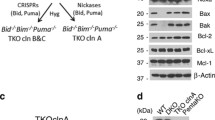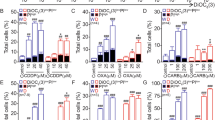Abstract
Induction of cell death by p14ARF is mediated through a Bax/Bak-dependent mitochondrial apoptosis pathway. To investigate the upstream signaling events required for the activation of Bax and/or Bak and to determine the functional impact of de-regulated cell cycle restriction point control in this context, we genetically dissected the impact of BH3-only proteins and the role of the cyclin-dependent kinase (cdk) inhibitor p21CDKN1. Using isogenic HCT116 colorectal cancer cells, either wild-type or homozygously deleted for the BH3-only protein Puma/bbc3 and/or p21CDKN1 or p53-reconstituted DU145 prostate cancer cells, we show that p14ARF-induced apoptosis is attenuated in the absence of Puma. Upon expression of p14ARF in HCT116 cells, Puma is rapidly induced at both the mRNA and protein level. Puma-proficient HCT116 cells undergo apoptotic (nuclear) DNA fragmentation, which is preceded by the N-terminal conformational change of Bax, the breakdown of the mitochondrial membrane potential, and induction of caspase-9 (LEHD)-like and caspase-3/7 (DEVD)-like activities. In contrast, p14ARF-induced apoptosis is markedly attenuated in isogenic HCT116 cells bi-allelically deleted for puma. The sensitivity of Puma-deficient cells to p14ARF-induced apoptosis is fully restored by functional reconstitution of Puma using a conditional adenoviral expression vector. Notably, the concomitant deletion of p21CDKN1 strongly enhances p14ARF-induced apoptosis in Puma-proficient cells, but not in isogenic Puma-deficient cells. These results indicate that p14ARF-induced mitochondrial apoptosis critically depends on the BH3-only protein Puma. In the presence of a functional p53/Puma/Bax-signaling axis, p14ARF-triggered apoptosis is enhanced by loss of p21CDKN1-mediated cell cycle checkpoint control.











Similar content being viewed by others
References
Sherr CJ (2004) Principles of tumor suppression. Cell 116:235–246
Sherr CJ (2006) Divorcing ARF and p53: an unsettled case. Nat Rev Cancer 6:663–673
Zindy F, Eischen CM, Randle DH, Kamijo T, Cleveland JL, Sherr CJ, Roussel MF (1998) Myc signaling via the ARF tumor suppressor regulates p53-dependent apoptosis and immortalization. Genes Dev 12:2424–2433
de Stanchina E, McCurrach ME, Zindy F, Shieh SY, Ferbeyre G, Samuelson AV, Prives C, Roussel MF, Sherr CJ, Lowe SW (1998) E1A signaling to p53 involves the p19(ARF) tumor suppressor. Genes Dev 12:2434–2442
Quelle DE, Zindy F, Ashmun RA, Sherr CJ (1995) Alternative reading frames of the INK4a tumor suppressor gene encode two unrelated proteins capable of inducing cell cycle arrest. Cell 83:993–1000
Hemmati PG, Gillissen B, von Haefen C, Wendt J, Starck L, Güner D, Dörken B, Daniel PT (2002) Adenovirus-mediated overexpression of p14(ARF) induces p53 and Bax-independent apoptosis. Oncogene 21:3149–3161
Normand G, Hemmati PG, Verdoodt B, von Haefen C, Wendt J, Güner D, May E, Dörken B, Daniel PT (2005) p14ARF induces G2 cell cycle arrest in p53- and p21-deficient cells by down-regulating p34cdc2 kinase activity. J Biol Chem 280:7118–7130
Eymin B, Claverie P, Salon C, Brambilla C, Brambilla E, Gazzeri S (2006) p14ARF triggers G2 arrest through ERK-mediated Cdc25C phosphorylation, ubiquitination and proteasomal degradation. Cell Cycle 5:759–765
Rocha S, Campbell KJ, Perkins ND (2003) p53- and Mdm2-independent repression of NF-kappa B transactivation by the ARF tumor suppressor. Mol Cell 12:15–25
Daniel PT, Schulze-Osthoff K, Belka C, Güner D (2003) Guardians of cell death: the Bcl-2 family proteins. Essays Biochem 39:73–88
Adams JM, Cory S (2007) The Bcl-2 apoptotic switch in cancer development and therapy. Oncogene 26:1324–1337
Huang DC, Strasser A (2000) BH3-only proteins-essential initiators of apoptotic cell death. Cell 103:839–842
Willis SN, Adams JM (2005) Life in the balance: how BH3-only proteins induce apoptosis. Curr Opin Cell Biol 17:617–625
Zong WX, Lindsten T, Ross AJ, MacGregor GR, Thompson CB (2001) BH3-only proteins that bind pro-survival Bcl-2 family members fail to induce apoptosis in the absence of Bax and Bak. Genes Dev 15:1481–1486
Desagher S, Osen-Sand A, Nichols A, Eskes R, Montessuit S, Lauper S, Maundrell K, Antonsson B, Martinou JC (1999) Bid-induced conformational change of Bax is responsible for mitochondrial cytochrome c release during apoptosis. J Cell Biol 144:891–901
Gillissen B, Essmann F, Graupner V, Starck L, Radetzki S, Dörken B, Schulze-Osthoff K, Daniel PT (2003) Induction of cell death by the BH3-only Bcl-2 homolog Nbk/Bik is mediated by an entirely Bax-dependent mitochondrial pathway. Embo J 22:3580–3590
Gillissen B, Essmann F, Hemmati PG, Richter A, Oztop I, Chinnadurai G, Dorken B, Daniel PT (2007) Mcl-1 determines the Bax dependency of Nbk/Bik-induced apoptosis. J Cell Biol 179:701–715
Sturm I, Stephan C, Gillissen B, Siebert R, Janz M, Radetzki S, Jung K, Loening S, Dörken B, Daniel PT (2006) Loss of the tissue-specific proapoptotic BH3-only protein Nbk/Bik is a unifying feature of renal cell carcinoma. Cell Death Differ 13:619–627
Zantl N, Weirich G, Zall H, Seiffert BM, Fischer SF, Kirschnek S, Hartmann C, Fritsch RM, Gillissen B, Daniel PT et al (2007) Frequent loss of expression of the pro-apoptotic protein Bim in renal cell carcinoma: evidence for contribution to apoptosis resistance. Oncogene 26:7038–48
Bouillet P, Metcalf D, Huang DC, Tarlinton DM, Kay TW, Kontgen F, Adams JM, Strasser A (1999) Proapoptotic Bcl-2 relative Bim required for certain apoptotic responses, leukocyte homeostasis, and to preclude autoimmunity. Science 286:1735–1738
Villunger A, Michalak EM, Coultas L, Mullauer F, Bock G, Ausserlechner MJ, Adams JM, Strasser A (2003) p53- and drug-induced apoptotic responses mediated by BH3-only proteins puma and noxa. Science 302:1036–1038
Tan TT, Degenhardt K, Nelson DA, Beaudoin B, Nieves-Neira W, Bouillet P, Villunger A, Adams JM, White E (2005) Key roles of BIM-driven apoptosis in epithelial tumors and rational chemotherapy. Cancer Cell 7:227–238
Kuroda J, Kimura S, Strasser A, Andreeff M, O'Reilly LA, Ashihara E, Kamitsuji Y, Yokota A, Kawata E, Takeuchi M et al (2007) Apoptosis-based dual molecular targeting by INNO-406, a second-generation Bcr-Abl inhibitor, and ABT-737, an inhibitor of antiapoptotic Bcl-2 proteins, against Bcr-Abl-positive leukemia. Cell Death Differ 14:1667–1677
Labi V, Erlacher M, Kiessling S, Villunger A (2006) BH3-only proteins in cell death initiation, malignant disease and anticancer therapy. Cell Death Differ 13:1325–1338
Labi V, Grespi F, Baumgartner F, Villunger A (2008) Targeting the Bcl-2-regulated apoptosis pathway by BH3 mimetics: a breakthrough in anticancer therapy? Cell Death Differ 15:977–987
Hemmati PG, Güner D, Gillissen B, Wendt J, von Haefen C, Chinnadurai G, Dörken B, Daniel PT (2006) Bak functionally complements for loss of Bax during p14ARF-induced mitochondrial apoptosis in human cancer cells. Oncogene 25:6582–6594
Yu J, Zhang L, Hwang PM, Kinzler KW, Vogelstein B (2001) PUMA induces the rapid apoptosis of colorectal cancer cells. Mol Cell 7:673–682
Waldman T, Kinzler KW, Vogelstein B (1995) p21 is necessary for the p53-mediated G1 arrest in human cancer cells. Cancer Res 55:5187–5190
Yu J, Wang Z, Kinzler KW, Vogelstein B, Zhang L (2003) PUMA mediates the apoptotic response to p53 in colorectal cancer cells. Proc Natl Acad Sci USA 100:1931–1936
Hemmati PG, Normand G, Verdoodt B, von Haefen C, Hasenjager A, Güner D, Wendt J, Dörken B, Daniel PT (2005) Loss of p21 disrupts p14 ARF-induced G1 cell cycle arrest but augments p14 ARF-induced apoptosis in human carcinoma cells. Oncogene 24:4114–4128
Jeffers JR, Parganas E, Lee Y, Yang C, Wang J, Brennan J, MacLean KH, Han J, Chittenden T, Ihle JN et al (2003) Puma is an essential mediator of p53-dependent and -independent apoptotic pathways. Cancer Cell 4:321–328
McStay GP, Salvesen GS, Green DR (2008) Overlapping cleavage motif selectivity of caspases: implications for analysis of apoptotic pathways. Cell Death Differ 15:322–331
Heath-Engel HM, Chang NC, Shore GC (2008) The endoplasmic reticulum in apoptosis and autophagy: role of the BCL-2 protein family. Oncogene 27:6419–6433
Erlacher M, Michalak EM, Kelly PN, Labi V, Niederegger H, Coultas L, Adams JM, Strasser A, Villunger A (2005) BH3-only proteins Puma and Bim are rate-limiting for gamma-radiation- and glucocorticoid-induced apoptosis of lymphoid cells in vivo. Blood 106:4131–4138
Erlacher M, Labi V, Manzl C, Bock G, Tzankov A, Hacker G, Michalak E, Strasser A, Villunger A (2006) Puma cooperates with Bim, the rate-limiting BH3-only protein in cell death during lymphocyte development, in apoptosis induction. J Exp Med 203:2939–2951
Radfar A, Unnikrishnan I, Lee HW, DePinho RA, Rosenberg N (1998) p19(Arf) induces p53-dependent apoptosis during Abelson virus-mediated pre-B cell transformation. Proc Natl Acad Sci USA 95:13194–13199
Cartron PF, Gallenne T, Bougras G, Gautier F, Manero F, Vusio P, Meflah K, Vallette FM, Juin P (2004) The first alpha helix of Bax plays a necessary role in its ligand-induced activation by the BH3-only proteins Bid and PUMA. Mol Cell 16:807–818
Kim H, Rafiuddin-Shah M, Tu HC, Jeffers JR, Zambetti GP, Hsieh JJ, Cheng EH (2006) Hierarchical regulation of mitochondrion-dependent apoptosis by BCL-2 subfamilies. Nat Cell Biol 8:1348–1358
Kuwana T, Bouchier-Hayes L, Chipuk JE, Bonzon C, Sullivan BA, Green DR, Newmeyer DD (2005) BH3 domains of BH3-only proteins differentially regulate Bax-mediated mitochondrial membrane permeabilization both directly and indirectly. Mol Cell 17:525–535
Certo M, Del Gaizo MV, Nishino M, Wei G, Korsmeyer S, Armstrong SA, Letai A (2006) Mitochondria primed by death signals determine cellular addiction to antiapoptotic BCL-2 family members. Cancer Cell 9:351–365
Ming L, Wang P, Bank A, Yu J, Zhang L (2006) PUMA dissociates Bax and Bcl-X(L) to induce apoptosis in colon cancer cells. J Biol Chem 281:16034–16042
Le HV, Minn AJ, Massague J (2005) Cyclin-dependent kinase inhibitors uncouple cell cycle progression from mitochondrial apoptotic functions in DNA-damaged cancer cells. J Biol Chem 280:32018–32025
Essmann F, Engels IH, Totzke G, Schulze-Osthoff K, Jänicke RU (2004) Apoptosis resistance of MCF-7 breast carcinoma cells to ionizing radiation is independent of p53 and cell cycle control but caused by the lack of caspase-3 and a caffeine-inhibitable event. Cancer Res 64:7065–7072
Wendt J, Radetzki S, von Haefen C, Hemmati PG, Güner D, Schulze-Osthoff K, Dörken B, Daniel PT (2006) Induction of p21CIP/WAF-1 and G2 arrest by ionizing irradiation impedes caspase-3-mediated apoptosis in human carcinoma cells. Oncogene 25:972–980
Hemmati PG, Normand G, Gillissen B, Wendt J, Dörken B, Daniel PT (2008) Cooperative effect of p21Cip1/WAF-1 and 14-3-3sigma on cell cycle arrest and apoptosis induction by p14ARF. Oncogene 27:6707–6719
Sohn D, Essmann F, Schulze-Osthoff K, Jänicke RU (2006) p21 blocks irradiation-induced apoptosis downstream of mitochondria by inhibition of cyclin-dependent kinase-mediated caspase-9 activation. Cancer Res 66:11254–11262
Jänicke RU, Sohn D, Essmann F, Schulze-Osthoff K (2007) The multiple battles fought by anti-apoptotic p21. Cell Cycle 6:407–413
Daniel PT (2000) Dissecting the pathways to death. Leukemia 14:2035–2044
Acknowledgments
This work was supported by the Deutsche Krebshilfe Grant 10-2088-Da3 to PTD and PGH. HCT116 cells and mutants were generously provided by Dr. Bert Vogelstein, Johns Hopkins Cancer Center, Baltimore, USA.
Disclosure statement
All authors have read and approved the final version of the manuscript. None of the authors has any type of financial interest to disclose.
Author information
Authors and Affiliations
Corresponding author
Additional information
Philipp G. Hemmati and Annika Müer contributed equally to this paper.
Rights and permissions
About this article
Cite this article
Hemmati, P.G., Müer, A., Gillissen, B. et al. Systematic genetic dissection of p14ARF-mediated mitochondrial cell death signaling reveals a key role for p21CDKN1 and the BH3-only protein Puma/bbc3. J Mol Med 88, 609–622 (2010). https://doi.org/10.1007/s00109-010-0606-5
Received:
Revised:
Accepted:
Published:
Issue Date:
DOI: https://doi.org/10.1007/s00109-010-0606-5




